The trick to being a great bass player: if it's hard to play, make it look easy. If it's easy, make it look hard.
Fun fact: Cliff Burton always made it look easy.
Friday, November 19, 2010
Monday, November 8, 2010
11.08.10 - Dimmu Borgir, Enslaved, Blood Red Throne
What cokehead decided a cavernous concrete and steel warehouse would make a great place for rock bands to perform? There's so much to hate about the Terminal 5 experience: The 20 minute walk to the nearest subway, the terrible sound and layout, the ludicrously early set times. What kind of black metal show gets out before 11 pm? Then again, a good part of the audience probably had to get up early the next morning to make first period, so maybe that's just as well.
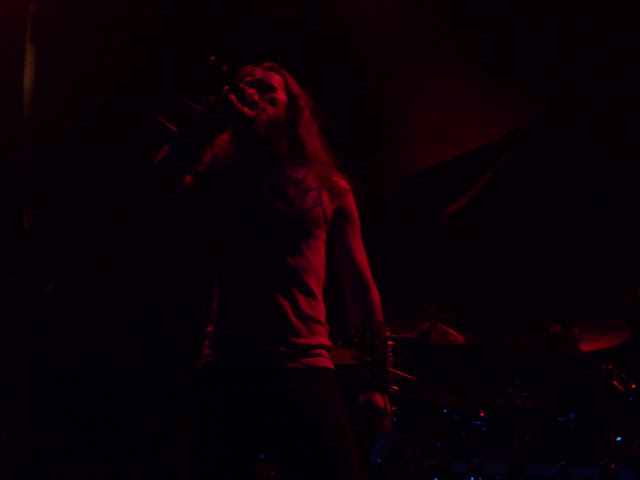
Blood Red Throne and their "everything new is old again" approach to mixing classic and contemporary death/thrash/black metal won over the audience, despite the muddy sound that neutered their impact. Which is a shame, because in a world without Zyklon and Myrkskog, BRT would be ideal candidates to take their place.
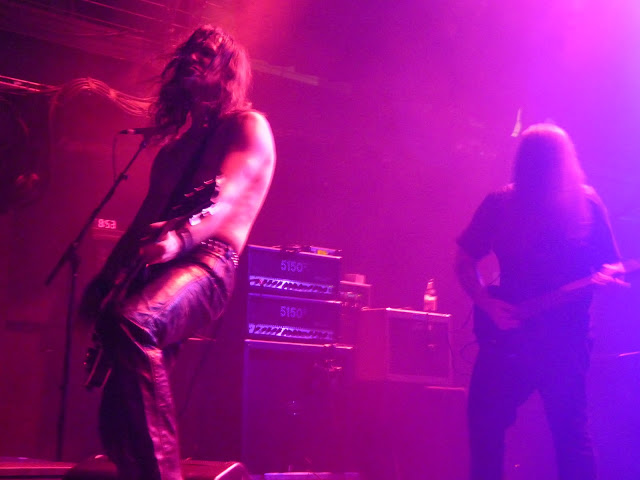

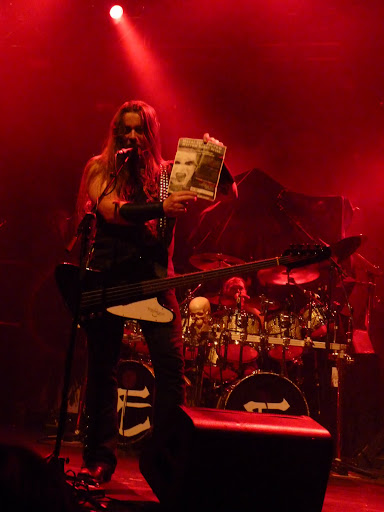 Enslaved may not have been the headliners, but they were the reason anyone with a brain showed up tonight. Luckily for them (and us), the sound cleared up, as they unleashed a short setlist that drew heavily from their excellent new album Axioma Ethica Odini. Singer/bassist Grutle Kjellson was born to walk the stage; contrary to their viking metal rep, it's clear that Enslaved live is as much a throwback to 70's prog as they are on record, pulling more classic rock poses than High on Fire. Midway through the set, Kjellson took time to inform the crowd about a bone marrow drive for Behemoth's Nergal; there's no way around it, these guys are the classiest black metal band around. A headlining tour is in order; 7 songs were not enough.
Enslaved may not have been the headliners, but they were the reason anyone with a brain showed up tonight. Luckily for them (and us), the sound cleared up, as they unleashed a short setlist that drew heavily from their excellent new album Axioma Ethica Odini. Singer/bassist Grutle Kjellson was born to walk the stage; contrary to their viking metal rep, it's clear that Enslaved live is as much a throwback to 70's prog as they are on record, pulling more classic rock poses than High on Fire. Midway through the set, Kjellson took time to inform the crowd about a bone marrow drive for Behemoth's Nergal; there's no way around it, these guys are the classiest black metal band around. A headlining tour is in order; 7 songs were not enough.
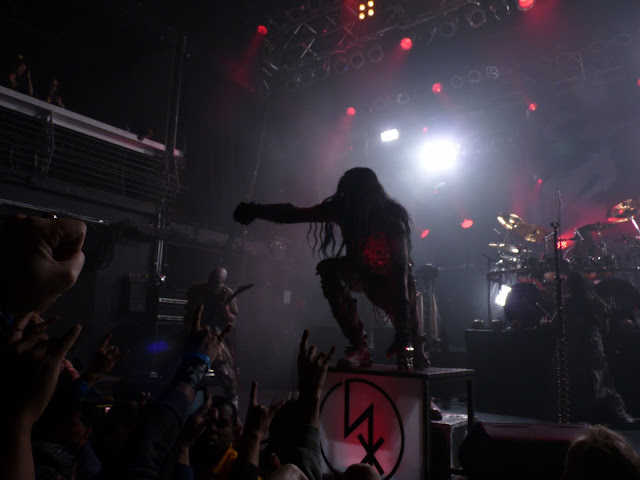
The last time I saw Dimmu Borgir, drummer Nick Barker and bassist/back-up vocalist Simen Hestnaes stole the show; both have since moved on, and Dimmu themselves haven't been the most inspiring of bands. Never the most proficient songwriters or musicians, they seem unable to write albums of sustained impact. This becomes most apparent when the likes of Keep of Kalessin pull the rug from under them with an album such as Reptilian that shames Dimmu in ability for what it lacks in budget.
But whatever their studio albums may lack, Dimmu Borgir makes up for with the sturm und drang of their live show. They were ever the most audacious of Norwegian black metal bands: the one who envisioned black metal as an all-encompassing spectacle that escaped the basement and reached out to the masses. Unlike, say, Emperor, who would never put their image ahead of their reputations as serious artists, Dimmu are performers above all; Shagrath brings to mind every arena rock frontman from Ozzy to Marilyn Manson who ever commanded the crowd to "SCREAAAAM LOUDER!"
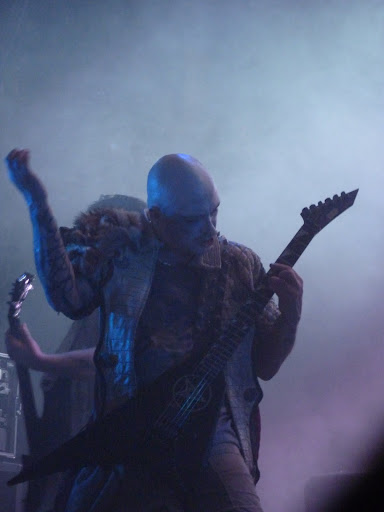 But best of all for me was Galder from Old Man's Child - very comfortable in his position as Dimmu's rhythm guitarist, he gurned shamelessly for the crowd and the cameras. Galder may rival Abbath as black metal's biggest ham, and god bless him for it.
But best of all for me was Galder from Old Man's Child - very comfortable in his position as Dimmu's rhythm guitarist, he gurned shamelessly for the crowd and the cameras. Galder may rival Abbath as black metal's biggest ham, and god bless him for it.
Like Cradle of Filth before them, Dimmu Borgir are a well crafted machine, one that's capable of moving effortlessly even if the individual parts keep changing. Their theatre troupe approach to metal is no less "false" then Gwar's, and should be held to the same standard. Whatever their standing in the world of KVLT, their consummate professionalism as entertainers can't be faulted. Simply put: I paid for a show and I got one.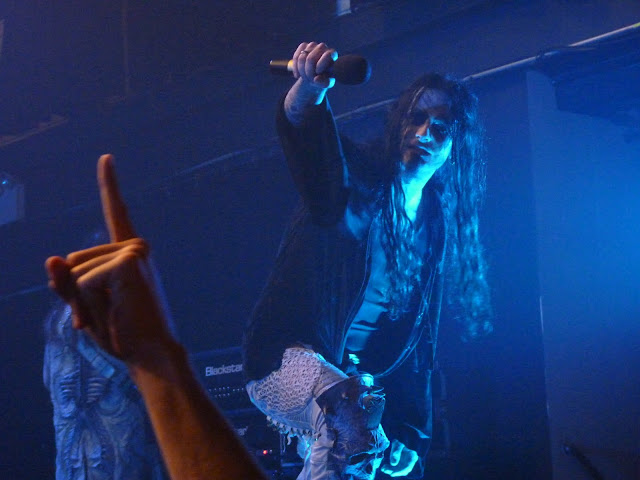
Blood Red Throne and their "everything new is old again" approach to mixing classic and contemporary death/thrash/black metal won over the audience, despite the muddy sound that neutered their impact. Which is a shame, because in a world without Zyklon and Myrkskog, BRT would be ideal candidates to take their place.
The last time I saw Dimmu Borgir, drummer Nick Barker and bassist/back-up vocalist Simen Hestnaes stole the show; both have since moved on, and Dimmu themselves haven't been the most inspiring of bands. Never the most proficient songwriters or musicians, they seem unable to write albums of sustained impact. This becomes most apparent when the likes of Keep of Kalessin pull the rug from under them with an album such as Reptilian that shames Dimmu in ability for what it lacks in budget.
But whatever their studio albums may lack, Dimmu Borgir makes up for with the sturm und drang of their live show. They were ever the most audacious of Norwegian black metal bands: the one who envisioned black metal as an all-encompassing spectacle that escaped the basement and reached out to the masses. Unlike, say, Emperor, who would never put their image ahead of their reputations as serious artists, Dimmu are performers above all; Shagrath brings to mind every arena rock frontman from Ozzy to Marilyn Manson who ever commanded the crowd to "SCREAAAAM LOUDER!"
Like Cradle of Filth before them, Dimmu Borgir are a well crafted machine, one that's capable of moving effortlessly even if the individual parts keep changing. Their theatre troupe approach to metal is no less "false" then Gwar's, and should be held to the same standard. Whatever their standing in the world of KVLT, their consummate professionalism as entertainers can't be faulted. Simply put: I paid for a show and I got one.
Sunday, November 7, 2010
Unleashed (pt. 2)
By 1991, Swedish death metal was in full swing: Dismember, Grave,and Unleashed all released their debut albums, and Entombed unveiled their monstrous second album Clandestine. Unleashed and Entombed were probably the two closest linked bands in the scene; both bands sprang from the remains of Nihilist, the legendary crew that jump-started the Stockholm metal explosion. The split between the two sides wasn't friendly; Entombed's Nicke Andersson would later admit that the demise of Nihilist was largely to get rid of singer/bassist Johnny Hedlund, who would soon form Unleashed.
This fascinating piece of inter-band drama sheds a lot of light on Unleashed and why they appear to be the odd men out from the rest of Stockholm's metal elite. Whereas the rest of their peers were synonymous with Tomas Skogsberg and Sunlight Studios, Unleashed would record their first album with Waldemar Sorychta (Century Media's in-house producer) and the rest on their own. Even in their approach to death metal, Unleashed eschewed the growing spectres of grind and tech-death for a stripped down, streamlined approach that recalls early Celtic Frost, Autopsy, and Death.
And of course, there's that viking schtick. Horror movie Satanism was Entombed's bag, and Dismember favored gore drenched misanthropy, but no band since Bathory did more to stake their claim to the "viking metal" tag than Unleashed. Hedlund drank mead from a ceremonial horn between playing songs about Norse mythology. That's a man who's chuffed with Vikings.
 Where No Life Dwells, Unleashed's debut, encapsulates a moment of time for death metal as well as any other album from that period. In much the same way as Grave and Bolt Thrower, this first Unleashed salvo alternates between full throttle thrashing and melody-inflected doom. Without twin guitar harmonies or alternating rhythms, Unleashed's approach to death metal is as barebones as it gets, and lacking that trademarked Sunlight Studios crunch, the sound is unusually dry, almost sterile compared to their Swedish peers.
Where No Life Dwells, Unleashed's debut, encapsulates a moment of time for death metal as well as any other album from that period. In much the same way as Grave and Bolt Thrower, this first Unleashed salvo alternates between full throttle thrashing and melody-inflected doom. Without twin guitar harmonies or alternating rhythms, Unleashed's approach to death metal is as barebones as it gets, and lacking that trademarked Sunlight Studios crunch, the sound is unusually dry, almost sterile compared to their Swedish peers.
 Unleashed's sophomore album, 1992's Shadows in the Deep, follows in much the same way as its predecessor, though with a touch more of its classic metal roots showing through on tracks like "The Immortals" and galloping title track. And as befitting a band that immersed themselves in history, the album covers a song from extreme metal's formative years, Venom's "Countess Bathory." While being an album that probably made Unleashed fans happy, it wasn't one that could be expected to create waves outside the world of metal. And it largely didn't, with the surprising exception that Dave Grohl recorded part of the song "Onward Into Countless Battles," which circulated for years as a Nirvana bootleg under the title "Dave's Meat Song".
Unleashed's sophomore album, 1992's Shadows in the Deep, follows in much the same way as its predecessor, though with a touch more of its classic metal roots showing through on tracks like "The Immortals" and galloping title track. And as befitting a band that immersed themselves in history, the album covers a song from extreme metal's formative years, Venom's "Countess Bathory." While being an album that probably made Unleashed fans happy, it wasn't one that could be expected to create waves outside the world of metal. And it largely didn't, with the surprising exception that Dave Grohl recorded part of the song "Onward Into Countless Battles," which circulated for years as a Nirvana bootleg under the title "Dave's Meat Song".
By 1993, changes were afoot in the world of death metal.
Bands like Napalm Death and Cannibal Corpse were regularly being played on MTV's Headbanger's Ball. Major labels, always in search of "the next big thing," found themselves knocking on the doors of Satan worshipers like Morbid Angel. During this period, the touchstone bands of the scene had begun incorporating a variety of influences, including prog rock (Death), classic metal (Carcass), and garage punk (Entombed). In fact, Sweden became ground zero for the scene-within-a-scene of "death & roll", as Grave and Dismember followed Entombed's lead and began incorporating more rock and roll elements into their Repulsion and Autopsy-fused DNA.
 Little if any of this had an effect on Unleashed, who carried on in the same galloping Viking metal vein as before. Their third album, 1993's Across the Open Sea was my introduction to them, discovered at a time when the words "swedish," "death," and "metal," when used in proximity to each other, would empty any and all cash I had into the nearest register. And yet, Unleashed had very little effect on my teenaged self. The production, bone-dry as usual, felt primitive and amateurish compared to the increasingly more expansive work of Tomas Skogsberg, Colin Richardson, Fredrik Nordström. An amusingly cowbell-heavy cover of "Breaking the Law" aside, Unleashed felt safe and predictable, especially when compared to the unruly likes of Entombed and Dismember.
Little if any of this had an effect on Unleashed, who carried on in the same galloping Viking metal vein as before. Their third album, 1993's Across the Open Sea was my introduction to them, discovered at a time when the words "swedish," "death," and "metal," when used in proximity to each other, would empty any and all cash I had into the nearest register. And yet, Unleashed had very little effect on my teenaged self. The production, bone-dry as usual, felt primitive and amateurish compared to the increasingly more expansive work of Tomas Skogsberg, Colin Richardson, Fredrik Nordström. An amusingly cowbell-heavy cover of "Breaking the Law" aside, Unleashed felt safe and predictable, especially when compared to the unruly likes of Entombed and Dismember.
The major stumbling block though were the vocals. There's no doubt in my mind that Johnny Hedlund is a legend; the term "Death Metal OG" was never more apt. And yet his vocals, a sandpaper rasp that often lacks power and range, always felt like a monotone afterthought over music that was already in danger of one dimensional. That, combined with the fact that he fronted a band that was hardly missed during its absence in the late 90's cemented in my mind that Unleashed were second-stringers in an increasingly more competitive and over-saturated death metal scene. And I would have stuck with that opinion if their most recent album hadn't forced me to re-appraise my view of them.
Going back to Across the Open Sea 13 years after I first heard it and dismissed it, I can appreciate its conviction and single minded sense of purpose. It's a fun record with, dare I say, an almost punk rock sensibility: No frills, not in the production, the songwriting, or the vocals. Unleashed as a band always paid tribute to their influences, be it as Scandinavians (through the viking imagery) or metalheads (by covering classic bands like Judas Priest and Venom). And that's what their albums sound like to me now: 4 guys who play metal for no other reason than because they love metal. In the end, Unleashed's first three albums are the work of a band who refused to be anything but heshers for life. As a 31 year-old in a Napalm Death hoodie, I can appreciate that.
This fascinating piece of inter-band drama sheds a lot of light on Unleashed and why they appear to be the odd men out from the rest of Stockholm's metal elite. Whereas the rest of their peers were synonymous with Tomas Skogsberg and Sunlight Studios, Unleashed would record their first album with Waldemar Sorychta (Century Media's in-house producer) and the rest on their own. Even in their approach to death metal, Unleashed eschewed the growing spectres of grind and tech-death for a stripped down, streamlined approach that recalls early Celtic Frost, Autopsy, and Death.
And of course, there's that viking schtick. Horror movie Satanism was Entombed's bag, and Dismember favored gore drenched misanthropy, but no band since Bathory did more to stake their claim to the "viking metal" tag than Unleashed. Hedlund drank mead from a ceremonial horn between playing songs about Norse mythology. That's a man who's chuffed with Vikings.
By 1993, changes were afoot in the world of death metal.
Bands like Napalm Death and Cannibal Corpse were regularly being played on MTV's Headbanger's Ball. Major labels, always in search of "the next big thing," found themselves knocking on the doors of Satan worshipers like Morbid Angel. During this period, the touchstone bands of the scene had begun incorporating a variety of influences, including prog rock (Death), classic metal (Carcass), and garage punk (Entombed). In fact, Sweden became ground zero for the scene-within-a-scene of "death & roll", as Grave and Dismember followed Entombed's lead and began incorporating more rock and roll elements into their Repulsion and Autopsy-fused DNA.
The major stumbling block though were the vocals. There's no doubt in my mind that Johnny Hedlund is a legend; the term "Death Metal OG" was never more apt. And yet his vocals, a sandpaper rasp that often lacks power and range, always felt like a monotone afterthought over music that was already in danger of one dimensional. That, combined with the fact that he fronted a band that was hardly missed during its absence in the late 90's cemented in my mind that Unleashed were second-stringers in an increasingly more competitive and over-saturated death metal scene. And I would have stuck with that opinion if their most recent album hadn't forced me to re-appraise my view of them.
Going back to Across the Open Sea 13 years after I first heard it and dismissed it, I can appreciate its conviction and single minded sense of purpose. It's a fun record with, dare I say, an almost punk rock sensibility: No frills, not in the production, the songwriting, or the vocals. Unleashed as a band always paid tribute to their influences, be it as Scandinavians (through the viking imagery) or metalheads (by covering classic bands like Judas Priest and Venom). And that's what their albums sound like to me now: 4 guys who play metal for no other reason than because they love metal. In the end, Unleashed's first three albums are the work of a band who refused to be anything but heshers for life. As a 31 year-old in a Napalm Death hoodie, I can appreciate that.
Thursday, November 4, 2010
Classical music for heshers
Shostakovich, #5, #10 and #11
Stravinski, "Rite of Spring"/"Firebird Suite"
Bartok, string quartets
Schnittke, "Requiem"
Penderecki, "Requiem"
Gorecki, 2nd Symphony/ "Totus Tuus"/ "Beatus Vir"
Gustav Holst, "The Planets"
Rachmaninov, "The Isle of the Dead"
Hector Berlioz, "Symphonie Fantastique"
Mussorgsky, "Night on Bald Mountain"
Janacek, "Sinfonietta"
Carl Orff, "Carmina Burana"
Mossolov, "Iron Foundry"
Investigations commence forthwith.
toe tags:
feeling listless
Subscribe to:
Posts
(
Atom
)
